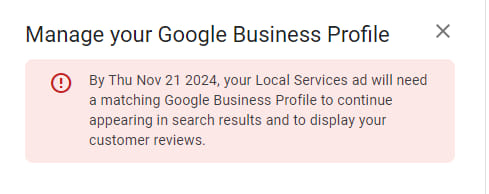
Understanding the Shift: Are GBP Reviews Replacing LSA Reviews?
BlogIs Google Replacing LSA Reviews With GBP Reviews? Let’s Break It Down Hey there, fellow SEO nerds! Have you ever felt like Google changes its rules faster than we can say “algorithm update”? Just when we finally wrap our heads around Local Service Ads (LSAs), rumors start swirling that Google Business Profile (GBP) reviews might be stealing the spotlight. Is this another case of Google shuffling the deck, or is there real substance here? Let’s grab a coffee (or a stress ball) and unpack this together. At Sitelinx Organic SEO Agency in Los Angeles, we’ve been knee-deep in Local SEO for years, helping businesses adapt to these shifts without losing their sanity. Spoiler alert: Whether you’re a bakery, a plumber, or a marketing consultant, GBP reviews are about to become your new best friend. What’s the Deal With LSA vs. GBP Reviews? First off, let’s clarify what we’re talking about. Local Service Ads (LSAs) are those handy “Google Guaranteed” badges you see for service-based businesses like HVAC companies or lawyers. They’re pay-per-lead ads that prioritize businesses with strong reviews and verification. Google Business Profile (GBP) reviews, on the other hand, are the star ratings and customer feedback tied directly to your business listing on Google Maps and Search. So why the buzz about one replacing the other? Well, Google’s been quietly testing ways to unify its platforms, and we’ve noticed a trend: GBP reviews are showing up in more places, even overlapping with traditional LSA territory. For example, some service ads now display GBP reviews alongside (or instead of) LSA-specific ratings. Is Google Actually Phasing Out LSA Reviews? Short answer: Not entirely—yet. But here’s the tea: Google’s doubling down on GBP as its central hub for local business credibility. Think of it like this: GBP is becoming the Swiss Army knife of local visibility, while LSAs are shifting toward a more niche role. Why does this matter? Simplicity: Managing one profile (GBP) is easier than juggling LSA and GBP separately. Trust: Customers recognize and rely on GBP reviews more consistently. SEO Synergy: A robust GBP profile boosts your Local SEO, which LSAs alone can’t match. At Sitelinx, we’ve seen clients who focus on GBP reviews gain better organic rankings and ad performance. It’s like getting a two-for-one deal—without the coupon clipping. The Nitty-Gritty: How GBP Reviews Are Stealing the Show Let’s get tactical. Here’s what’s changing and how to adapt: 1. Google’s Love Affair With Unified Profiles Google’s been merging features from LSAs into GBP, like service areas, booking buttons, and yes—reviews. If your GBP isn’t optimized, you’re basically leaving money on the table. Pro Tip: Update your GBP daily. Add fresh photos, respond to reviews (even the grumpy ones), and use keywords in your business description. Need help? That’s what an SEO company like ours lives for. 2. The SEO Ripple Effect GBP reviews don’t just influence customers—they’re a Local SEO goldmine. Google weighs reviews heavily in local pack rankings. More (positive) reviews = better visibility. Simple math, right? Fun Fact: One client, a dog groomer in LA, saw a 40% traffic boost after we streamlined their GBP and WordPress SEO services. Turns out, puppies and algorithms love consistency. 3. The Slow Fade of LSA-Only Strategies LSAs aren’t dead, but they’re no longer the solo act. Combining LSAs with a rock-solid GBP profile is now the winning playbook. “But Wait—What Should I Actually Do?” Glad you asked! Here’s your action plan: Audit Your GBP Profile Is every field filled out? (Including those pesky service categories?) Do you have at least 20 reviews? (No? Time to kindly ask happy clients for feedback.) Are you using Google Posts? (If not, you’re missing free promo space.) Sync LSA and GBP Efforts Use the same keywords, services, and contact info across both. Redirect LSA review requests to your GBP page. Invest in Technical SEO Services A fast, mobile-friendly site (looking at you, WordPress users) complements your GBP work. Fix crawl errors, optimize metadata, and embrace structured data. FYI: The best SEO companies for small business—like, ahem, Sitelinx—specialize in making this process painless. Just saying. The Bigger Picture: Why This Shift Matters Let’s zoom out. Google’s moves always hint at their endgame. By prioritizing GBP, they’re pushing businesses to: Be more transparent (no more hiding behind ads). Engage authentically (respond to reviews, post updates). Play the long game (SEO over quick fixes). Translation: If you’ve been treating GBP as an afterthought, it’s time for a wake-up call. And hey, if you’re overwhelmed, that’s what SEO specialists are for. Wink. Your Burning Questions, Answered Let’s tackle three common FAQs we hear at Sitelinx: Q: “Is Google deleting LSA reviews?” A: Not exactly—but they’re emphasizing GBP reviews more. Merge your strategies to stay safe. Q: “How do I improve my GBP ranking?” A: Post regularly, gather reviews, and nail your technical SEO services. Oh, and work with an SEO agency that gets it. Q: “Can I ignore LSAs now?” A: Not if you’re in a competitive industry! Use LSAs for instant visibility, but build your GBP for lasting results. Wrapping Up: Don’t Panic—Optimize! So, is Google replacing LSA reviews with GBP? Kinda, sorta, maybe. The real takeaway? GBP is your foundation, and everything else (LSAs, ads, even your WordPress website management) should orbit around it. At Sitelinx Organic SEO Agency, we’ve helped dozens of LA businesses pivot without missing a beat. Whether you need a marketing consultant to strategize or an SEO specialist to handle the dirty work, we’ve got your back. Final thought: Google’s gonna Google. But with a little humor and a lot of grit, we can keep our businesses thriving. Now, go update that GBP profile—or let us do it for you. 😉 Need a hand? Reach out to Sitelinx Organic SEO Agency—we’re here to turn Google’s chaos into your competitive edge. Let’s chat!

Ultimate Guide to Launching a Successful Carpentry Business in 2025
How ToHow to Start a Carpentry Business (Without Losing a Finger or Your Mind) So, you’ve decided to turn your love for sawdust, chisels, and perfectly sanded edges into a legit carpentry business. Congrats! You’re about to join the ranks of folks who get paid to create things that don’t involve Excel spreadsheets. But let’s be real—starting a carpentry biz isn’t just about building stuff. It’s also about marketing, branding, and not accidentally turning your garage into a lumberyard black hole. Don’t worry, though. We’ve got your back. Let’s break this down step by step, with a little help from our friends at Sitelinx Organic SEO Agency here in Los Angeles. (Spoiler: They’re the best SEO company for small businesses if you want to avoid being invisible online.) Step 1: Define Your Niche (Because “I Build Stuff” Isn’t a Business Plan) First things first: What’s your carpentry superpower? Are you the custom furniture wizard? The deck-building guru? The tiny-house-on-wheels maestro? Picking a niche isn’t just about passion—it’s about standing out in a crowded market. Pro Tip: Residential vs. Commercial: Residential work (think kitchen cabinets) often has quicker turnaround times, while commercial projects (office build-outs) can mean bigger budgets but longer timelines. Specialty Services: Restorations, eco-friendly builds, or even custom wood art can command premium pricing. Ever tried explaining dovetail joints to someone who thinks a hammer is just for hanging pictures? Yeah, niching down helps you attract clients who get your value. Step 2: Craft a Business Plan That Doesn’t Put You to Sleep We know, we know—business plans sound about as fun as sanding plywood for eight hours straight. But trust us, skipping this step is like building a cabinet without measuring twice. Here’s the CliffsNotes version: Know Your Numbers Startup Costs: Tools ($2k–$10k), insurance ($500–$1.5k/year), permits ($100–$500), and a website (more on that later). Pricing: Hourly rates ($30–$75+) or project-based fees. Don’t forget materials markup (15–30%). Legal Stuff Made Simple Business Structure: LLCs are popular for liability protection. Licenses: Most states require a contractor’s license for jobs over $500. Check your local rules—or risk fines that’ll make your wallet cry. FYI: If paperwork makes you want to hide in your workshop, hire a marketing consultant or SEO specialist (like our pals at Sitelinx) to handle the digital heavy lifting while you focus on saws and stains. Step 3: Branding That Doesn’t Look Like a 1998 Geocities Page Your brand is more than a logo. It’s the vibe people get when they see your work or visit your website. And no, Comic Sans isn’t a vibe—it’s a crime. Key Branding Ingredients: Name: Keep it simple and memorable. “Dave’s Custom Carpentry” > “Artisanal Woodcraft Solutions, LLC.” Visual Identity: Colors, fonts, and a logo that says “pro” without screaming “I spent my entire budget on this.” Website: Non-negotiable. Use WordPress for flexibility—it’s like the Swiss Army knife of website platforms. Pair it with WordPress SEO services (shout-out to Sitelinx) to make sure Google actually notices you. Step 4: Get Online Without Falling Into the Internet Void Let’s be blunt: If your website looks like it was built by your cousin’s neighbor’s dog, clients will bounce faster than a nail gun misfire. Here’s how to avoid that: Website Must-Haves Portfolio Gallery: Show off your best work. Before/after shots? Chef’s kiss. Service Pages: Detail what you offer (e.g., “Custom Built-Ins” or “Outdoor Structures”). SEO Optimization: Sprinkle keywords like “custom carpentry [Your City]” naturally. Need help? Sitelinx Organic SEO Agency offers technical SEO services that’ll make your site faster and friendlier to search engines. Google Business Reviews: Your New Best Friend 90% of customers check reviews before hiring. Ask happy clients to leave feedback on your Google Business Profile. Not ranking well locally? That’s where Local SEO comes in—a specialty of, you guessed it, our friends at Sitelinx. Step 5: Market Like a Pro (Without Being That Guy) Marketing doesn’t have to mean cold-calling strangers or spamming Facebook groups. Here’s how to grow your biz without being a pest: Social Media: Instagram and Pinterest are gold for visual trades. Post time-lapse builds or behind-the-scenes chaos. Networking: Partner with interior designers, realtors, or hardware stores. Offer them a referral fee—it’s cheaper than ads. Email Lists: Collect emails (offer a free “5 Tips for Maintaining Wood Furniture” guide) and send updates occasionally. Hot Take: If you’re overwhelmed by website management or SEO services, hire a SEO agency. Sitelinx specializes in helping small businesses like yours stop yelling into the void and start attracting real clients. Step 6: Scale Without Losing Your Soul (or Sleep) Once you’re booked solid, it’s time to grow. But scaling doesn’t mean working 20-hour days. Try these instead: Hire Help: Train an apprentice or outsource admin tasks. Raise Prices: If you’re swamped, you’re too cheap. Systems: Use project management tools (Trello, Asana) to streamline workflows. Pro Move: Invest in technical SEO services to keep your site running smoothly as traffic grows. Sitelinx is one of the best SEO companies for small business owners who want to scale without tech headaches. 3 Burning Questions (Answered Without the Fluff) 1. “Do I really need a license?” Yes. Unless you enjoy legal drama. Check your state’s requirements—most mandate licenses for jobs above a certain dollar amount. 2. “How do I stand out from other carpenters?” Specialize in something weirdly specific (like reclaimed wood baby cribs) and crush your Local SEO so people can actually find you. 3. “Can I make a living doing this?” Absolutely. The average carpenter earns $50k/year, but niche experts and those with killer Google Business reviews can hit six figures. Final Thoughts: Sawdust, SEO, and Success Starting a carpentry business is equal parts craftsmanship and strategy. Build a solid foundation (pun intended) with a clear niche, a professional online presence, and marketing that doesn’t make people roll their eyes. And if the digital stuff feels like trying to assemble IKEA furniture without instructions? Hit up Sitelinx Organic SEO Agency. They’re the SEO company that’ll handle the tech voodoo while you focus
